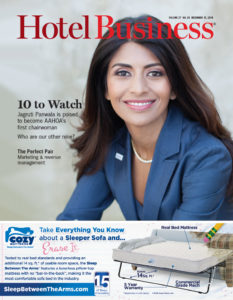With the pressure on, AAHOA’s Jagruti Panwala has a game plan in place for the coming year. “Being the first chairwoman—it’s a lot of responsibility,” she said. While some of her priorities for 2019 are pulled from ongoing AAHOA initiatives, there are other items on her agenda she’s been waiting to push forward to change the association for better.
“Our number-one strength is political advocacy,” Panwala said of AAHOA, the hotel industry’s largest hotel owners organization, which now has more than 18,500 members. “[Over the years], the change of awareness of the association on the political side has increased so dramatically.”
With regard to political advocacy, there’s still room for growth, however, especially at state and local levels. “Since our focus has been on federal, there were times that we were missing out on doing what we needed to do for our members, and we recognized that,” she said.
For example, Oklahoma’s state government in March 2018 tried increasing the state’s hotel room charge by $5 in a revenue bill. “We found this out the same day the bill was going through,” she said. Even though AAHOA’s members had the proposed tax removed from the bill, the association could’ve been a bit more proactive.
“This is not just going to happen in Oklahoma,” she said. “It’s going to happen in a lot of different areas, so we’re implementing a plan in 2019—a state and local plan for our organization.”
Another initiative in 2019 for AAHOA’s incoming chairwoman, which has been at the top of the list for AAHOA and the industry in general, is human trafficking. “Unfortunately, this happens in hotels,” Panwala said. The association has been providing free training in this area to its own members. To date, AAHOA has certified more than 3,000 members.
“[AAHOA’s] goal is to make sure that every single member and their staff at the hotels are trained,” she said. “We are also working with all the brands to make it mandatory for every single owner to make sure that they have certification at their properties.”
In addition to her role at AAHOA, she’s president and CEO of Wealth Protection Strategies, a full-service financial planning firm she began about eight years ago. It makes sense, then, she’d like to leverage this background to find ways to improve AAHOA’s financial health. “Even though AAHOA is in a really good place financially, I want to make sure we are creating a revenue stream from the vendor side that creates a long-term solution instead of year-to-year,” Panwala said. If she can’t accomplish this initiative during her tenure, she’d like to ensure she at least gets the process underway.
“Another thing I’d like to do is really get involved in a lot of universities and bring young kids into hospitality,” she said. “I made a decision—and I’ve told our president—that I want to speak at as many universities as possible.”
Despite what some in the industry believe, younger generations want to become involved in the hotel business, but they don’t know how, according to Panwala. “If we can create a program for the students in the association, so it’s an easy roadmap for them to get into hospitality, that would be huge,” Panwala said. While there are many young professionals joining AAHOA, she’d like to see the association bring in more students.
Of course, as AAHOA’s first chairwoman, she has plans to continue to not only grow AAHOA’s membership in general but the involvement of women, too. Recalling when she first became involved with the association, she said: “I was shocked that really there were few women there. Any meetings I went to, out of 100 men, there were barely two or three women, and that really surprised me.”
Now, due to her having been in several leadership positions over the years and the efforts of others—including many other women—in the association, nearly half of AAHOA’s members (40%) are women.
While member needs have evolved throughout the association’s history—there’s now more of a focus on technology, finance and hospitality law—women are still struggling with maintaining a healthy work/life balance.
“That is so important,” Panwala said. “It’s still a continuous struggle for women because it is not an easy task when you’re traveling a lot. I don’t know at what point we’re all going to find that balance, but it’s not an easy task.”
As far as her leadership style is concerned, she expects to lead with two Ps front and center: persistence and patience. These two leadership traits have gotten her this far, and she plans to use both traits in her role as AAHOA’s first-ever chairwoman.
“A leader has to lead by example,” she said. “This is not just a cliché. I truly believe that—because I can stand on stage and say a million things, and if I don’t do it myself, then really, it makes no difference. It doesn’t bring any value to it. I always ask myself before I preach, ‘Is this something that I truly believe in?’ Is it something that I would do before I ask somebody else to follow through with it?” HB

